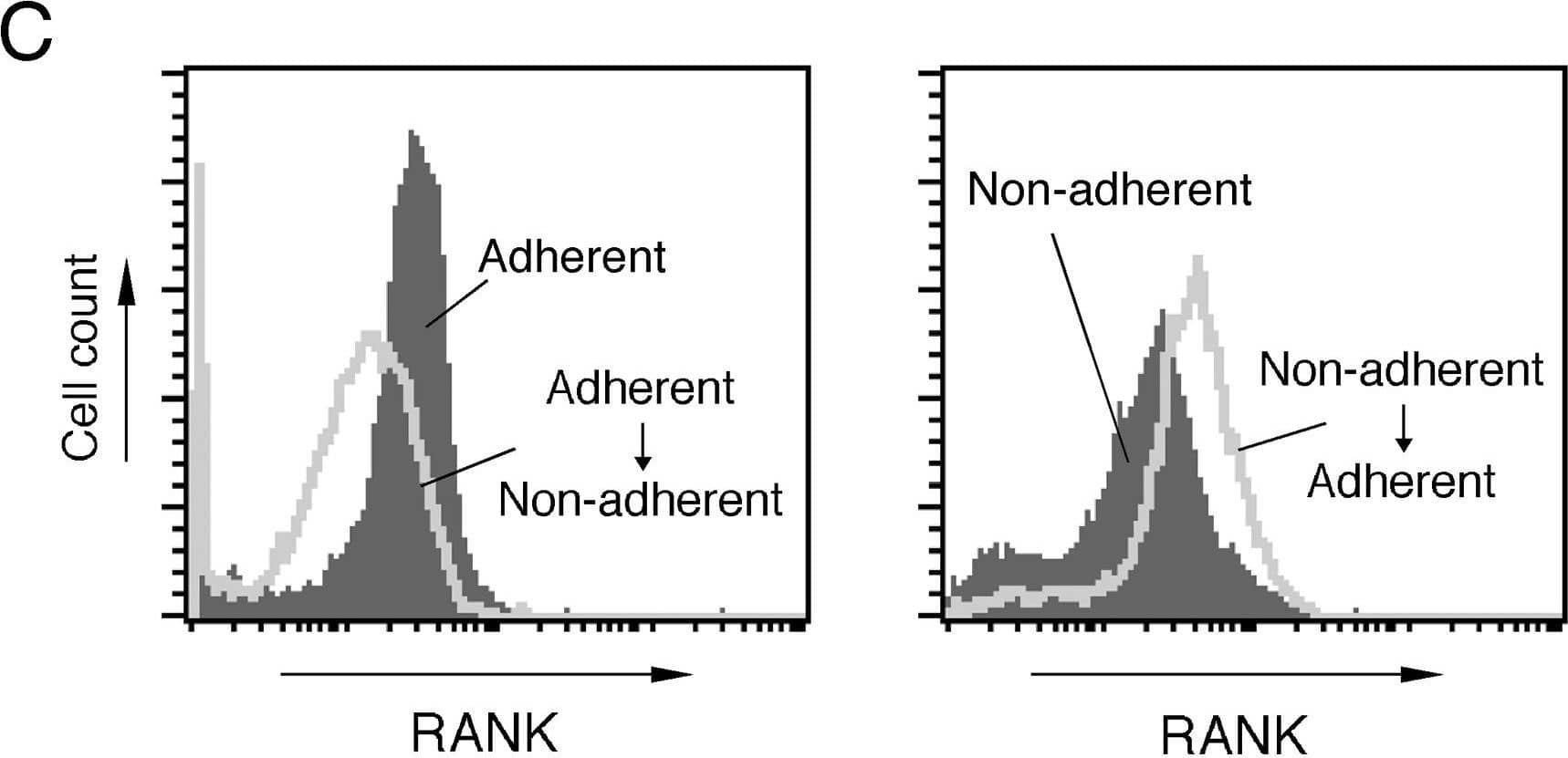Mouse RANK/TNFRSF11A Biotinylated Antibody Summary
Gln30-Pro213
Accession # O35305
Applications
Please Note: Optimal dilutions should be determined by each laboratory for each application. General Protocols are available in the Technical Information section on our website.
Scientific Data
 View Larger
View Larger
Detection of RANK/TNFRSF11A by Flow Cytometry RANK expression levels under adherent and non-adherent conditions.A. BMMs under the adherent condition were harvested (0 h) and subsequently cultured again under adherent and non-adherent conditions in the presence or absence of M-CSF (50 ng/ml), TGF-beta (1 ng/ml), and RANKL (150 ng/ml) for the indicated periods. Relative expression levels of RANK mRNA were determined by real time RT-PCR. Data represent mean values of three independent experiments, with error bars indicating ± SD. **P< 0.01 for adherent condition vs. non-adherent condition at the same time point. B. Left panel: BMMs grown under the adherent condition were transferred to the non-adherent condition and further cultured for the indicated time periods. Right panel: BMMs under the non-adherent condition were transferred to the adherent condition and further cultured for the indicated time periods. RANK mRNA expression was analyzed by RT-PCR. C. Left panel: comparison of RANK protein expression levels between BMMs cultured under the adherent condition and those transferred to the non-adherent condition. Right panel: Comparison of RANK protein levels between BMMs cultured under the non-adherent condition and those transferred to the adherent condition. RANK protein expression on the surface of BMMs was analyzed by flowcytometry. Image collected and cropped by CiteAb from the following open publication (https://pubmed.ncbi.nlm.nih.gov/23139818), licensed under a CC-BY license. Not internally tested by R&D Systems.
Reconstitution Calculator
Preparation and Storage
- 12 months from date of receipt, -20 to -70 °C as supplied.
- 1 month, 2 to 8 °C under sterile conditions after reconstitution.
- 6 months, -20 to -70 °C under sterile conditions after reconstitution.
Background: RANK/TNFRSF11A
RANK (receptor activator of NF-kappa B, also known as TRANCE receptor, osteoclast differentiation factor receptor [ODFR] and TNFRSF11A) is a member of the tumor necrosis factor receptor family. The full length mouse RANK cDNA encodes a type I transmembrane protein of 625 amino acids (aa) with a predicted 184 aa extracellular domain and a 391 aa cytoplasmic domain. The extracellular domain contains two potential N-linked glycosylation sites. RANK shares significant amino acid homology with other members of the TNF R family in its extracellular four cysteine-rich repeats. Human and murine RANK share 81% aa identity in their extracellular domains. RANK is widely expressed with the highest levels in skeletal muscle, thymus, liver, colon, small intestine and adrenal gland. RANK is expressed in dendritic cells. In activated human peripheral blood T lymphocytes, RANK expression is induced by IL-4 and TGF-beta. Multiple tumor necrosis factor receptor-associated factors (TRAFs) are involved in the signaling of RANK. TRANCE (TNF-related activation-induced cytokines, also known as RANK ligand [RANKL], osteoprotegerin ligand [OPGL], and osteoclast differentiation factor [ODF]) is the ligand for RANK. The biological functions mediated through RANK include activation of NF-kappa B and c-jun N-terminal kinase, enhancement of T cell growth and dendritic cell function, induction of osteoclastogenesis, and lymph node organogenesis. Soluble RANK is able to block TRANCE induced biological activity.
- Anderson, D.M. et al. (1997) Nature 390:175.
- Nakagawa, N. et al. (1998) Biochem. Biophys. Res. Commun. 245:382.
Product Datasheets
Citations for Mouse RANK/TNFRSF11A Biotinylated Antibody
R&D Systems personnel manually curate a database that contains references using R&D Systems products. The data collected includes not only links to publications in PubMed, but also provides information about sample types, species, and experimental conditions.
7
Citations: Showing 1 - 7
Filter your results:
Filter by:
-
RANKL Inhibition Reduces Cardiac Hypertrophy in mdx Mice and Possibly in Children with Duchenne Muscular Dystrophy
Authors: Marcadet L, Juracic ES, Khan N et al.
Cells
-
RANK links thymic regulatory T cells to fetal loss and gestational diabetes in pregnancy
Authors: M Paolino, R Koglgruber, SJF Cronin, I Uribesalgo, E Rauscher, J Harreiter, M Schuster, D Bancher-To, B Pranjic, M Novatchkov, JP Fededa, AJ White, V Sigl, S Dekan, T Penz, C Bock, L Kenner, GA Holländer, G Anderson, A Kautzky-Wi, JM Penninger
Nature, 2020-12-23;0(0):.
Species: Mouse
Sample Types: Whole Tissue
Applications: IHC -
Porphyromonas gingivalis-derived lysine gingipain enhances osteoclast differentiation induced by tumor necrosis factor-alpha and interleukin-1beta but suppresses that by interleukin-17A: importance of proteolytic degradation of osteoprotegerin by lysine gingipain.
Authors: Akiyama T, Miyamoto Y, Yoshimura K, Yamada A, Takami M, Suzawa T, Hoshino M, Imamura T, Akiyama C, Yasuhara R, Mishima K, Maruyama T, Kohda C, Tanaka K, Potempa J, Yasuda H, Baba K, Kamijo R
J Biol Chem, 2014-04-22;289(22):15621-30.
Species: Mouse
Sample Types: Cell Lysates
Applications: Western Blot -
Cell Adhesion Signaling Regulates RANK Expression in Osteoclast Precursors
Authors: Ayako Mochizuki, Masamichi Takami, Yoichi Miyamoto, Tsuyoshi Nakamaki, Shigeru Tomoyasu, Yuho Kadono et al.
PLoS ONE
-
Fos plays an essential role in the upregulation of RANK expression in osteoclast precursors within the bone microenvironment.
Authors: Arai A, Mizoguchi T, Harada S, Kobayashi Y, Nakamichi Y, Yasuda H, Penninger J, Yamada K, Udagawa N, Takahashi N
J Cell Sci, 2012-03-27;125(0):2910-7.
Species: Mouse
Sample Types: Whole Tissue
Applications: IHC-Fr -
siRNA Knock-Down of RANK Signaling to Control Osteoclast-Mediated Bone Resorption
Authors: Yuwei Wang, David W. Grainger
Pharmaceutical Research
-
Identifying the relative contributions of Rac1 and Rac2 to osteoclastogenesis.
Authors: Wang Y, Lebowitz D, Sun C, Thang H, Grynpas MD, Glogauer M
J. Bone Miner. Res., 2008-02-01;23(2):260-70.
Species: Mouse
Sample Types: Cell Lysates
Applications: Western Blot
FAQs
No product specific FAQs exist for this product, however you may
View all Antibody FAQsReviews for Mouse RANK/TNFRSF11A Biotinylated Antibody
There are currently no reviews for this product. Be the first to review Mouse RANK/TNFRSF11A Biotinylated Antibody and earn rewards!
Have you used Mouse RANK/TNFRSF11A Biotinylated Antibody?
Submit a review and receive an Amazon gift card.
$25/€18/£15/$25CAN/¥75 Yuan/¥2500 Yen for a review with an image
$10/€7/£6/$10 CAD/¥70 Yuan/¥1110 Yen for a review without an image

